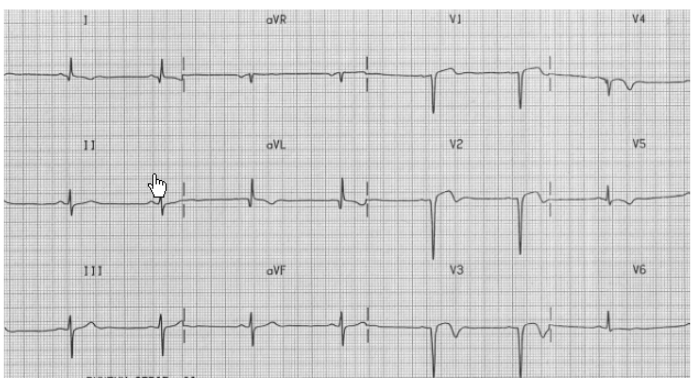ACLS Megacode Scenario 8
By Mark Dzwonkiewicz, FP-C, LI | Medically reviewed by Lisa Wright, MHA, RRT-NPS on October 2, 2024
Quiz Summary
0 of 7 questions completed
Questions:
- 1
- 2
- 3
- 4
- 5
- 6
- 7
The results of your practice test are waiting! Just fill in your email address in the box below, and we will share your results. You’ll only need to enter your email one time. After taking your next practice exam, you’ll receive your results as soon as you click on “Submit.”
Once you pass five practice tests, a 20% discount coupon will immediately be sent to the email address you provided.
You have already completed the quiz before. Hence you can not start it again.
Quiz is loading…
You must sign in or sign up to start the quiz.
You must first complete the following:
Results
Time has elapsed
Try Again. You didn’t get a passing score.Congratulations! You Passed.
You got 0 out of 0 correct and scored 0. Review your incorrect answers and try again.
Earned Point(s): 0 of 0, (0)
0 Essay(s) Pending (Possible Point(s): 0)
Categories
- Not categorized 0%
Earn a 20% Discount on Your Next Certification Course!
ACLScertification.org is proud to offer a 20% discount to students who successfully pass 5 of our practice tests in one sitting. Currently, you have passed 0 of the 5 required tests. Start testing your skills and earning your discount now in our Practice Exam Section.
- 1
- 2
- 3
- 4
- 5
- 6
- 7
- Answered
- Review
-
Question 1 of 7
1. Question
You are in the emergency department when the triage nurse wheels in a man who is complaining of chest pain.He is breathing rapidly and shallowly and is clutching his chest. His color is ashen, and his face is gleaming with sweat. As you assist the patient into a bed, his wife tells you that the patient is 62 years old. He is diabetic (type 2). He quit smoking five years ago. He has high blood pressure and high cholesterol. He has no allergies and is currently taking metformin for his diabetes, atorvastatin for his hypocholesteremia, and hydrochlorothiazide (HCTZ) for blood pressure control. She tells you that he saw his doctor last week and was counseled to lose weight. He weighs 97.5 kilograms (215 pounds).
The pain started about an hour ago and was unrelieved by antacids. The patient describes the pain as constant and “squeezing” in nature. He tells you the pain is right behind his breastbone and radiates to the left shoulder and left arm. He feels nauseated but has not vomited. The patient appears anxious. He admits to feeling slightly short of breath. He tells you that he is scared and states, “I feel like I’m going to die.”
You call for help and put the patient on the monitor.
You obtain a set of vital signs: temperature 37.2°C; HR 178 bpm and regular; RR 22 breaths per minute and shallow; BP 156/92 mmHg; and SpO2 93% on room air.
The monitor reveals the following:

1. What rhythm is displayed on the monitor?
CorrectIncorrect -
Question 2 of 7
2. Question
2. You are not 100% sure whether the rhythm is sinus tachycardia because the rapidity of the rhythm makes it difficult to distinguish any P waves. What intervention can be done to attempt to slow the rhythm so that P waves (if present) can be identified?
CorrectIncorrect -
Question 3 of 7
3. Question
You know that vagal maneuvers must be performed cautiously in someone who may be having a heart attack.You ask the patient to bear down briefly while holding their breath. The patient’s heart rate slows down to 85. You identify P waves.
You ask the unit clerk to page the physician on-call and order a stat 12-lead ECG and a chest x-ray. You ask another nurse to insert an IV and draw blood for CBC, electrolytes, a coagulation profile, and cardiac enzymes. You ascertain that the patient has no allergies.
What other medication should be considered at this time?
CorrectIncorrect -
Question 4 of 7
4. Question
You ascertain that the patient has never taken a phosphodiesterase inhibitor and give a single spray of nitroglycerin (0.4 mg) under the patient’s tongue.You have the patient chew 325 mg aspirin. Meanwhile, the 12-lead ECG is completed.

You identify ST elevation on the 12-lead ECG, and you decide that the patient has a myocardial infarction.
4. Which leads on the ECG show ST elevation?
CorrectIncorrect -
Question 5 of 7
5. Question
The cardiac cath lab is currently full and it will be at least an hour before they can treat this patient.Waiting to send the patient to the cath lab represents an unacceptable delay. Based on the patient’s ECG showing an anterior MI, you decide that the patient requires fibrinolytic therapy.
5. What is the door-to-needle goal for fibrinolytic therapy for acute coronary syndrome?
CorrectIncorrect -
Question 6 of 7
6. Question
6. What is NOT a contradiction to receiving fibrinolytic therapy for acute coronary syndrome?
CorrectIncorrect -
Question 7 of 7
7. Question
You begin reviewing the risks and benefits of reperfusion therapy and determine that the patient has no conditions that would preclude this therapy.The patient receives fibrinolytic therapy. After 10 minutes, you note a change on the monitor.

7. What rhythm is displayed on the monitor?
CorrectIncorrect
ACLS Megacode Scenario 8 Video
ACLS Certification Association videos have been peer-reviewed for medical accuracy by the ACA medical review board.
More Free Resources to Keep You at Your Best
Editorial Note
ACLS Certification Association (ACA) uses only high-quality medical resources and peer-reviewed studies to support the facts within our articles. Explore our editorial process to learn how our content reflects clinical accuracy and the latest best practices in medicine. As an ACA Authorized Training Center, all content is reviewed for medical accuracy by the ACA Medical Review Board.